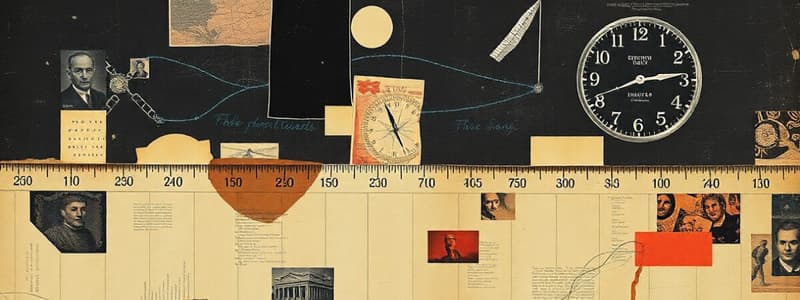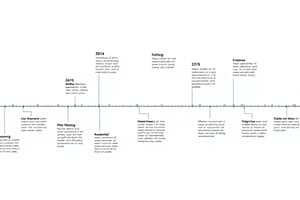Podcast
Questions and Answers
What indicates a break in even spacing on a timeline?
What indicates a break in even spacing on a timeline?
- A slanted or jagged line (correct)
- A straight line
- A highlighted area
- A dotted line
Timelines can show events and their dates on a single timeline only.
Timelines can show events and their dates on a single timeline only.
False (B)
What is the purpose of a multilevel timeline?
What is the purpose of a multilevel timeline?
To compare events in different places at certain periods of time.
A timeline labels historical events alongside the ______ when the event took place.
A timeline labels historical events alongside the ______ when the event took place.
Match the following timeline features with their descriptions:
Match the following timeline features with their descriptions:
Which of the following is a term that describes a period of 10 years?
Which of the following is a term that describes a period of 10 years?
AD stands for 'After Death'.
AD stands for 'After Death'.
What is a timeline?
What is a timeline?
The year 1 AD marks the beginning of _____ years.
The year 1 AD marks the beginning of _____ years.
Match the following terms with their definitions:
Match the following terms with their definitions:
How are BC years counted?
How are BC years counted?
What is the reference point commonly used to measure historical time?
What is the reference point commonly used to measure historical time?
A millennium is equal to 500 years.
A millennium is equal to 500 years.
What does A.D stand for?
What does A.D stand for?
The year 100 A.D is in the 2nd Century.
The year 100 A.D is in the 2nd Century.
What is the year that marks the beginning of the 1st Century?
What is the year that marks the beginning of the 1st Century?
The year 56 BC is in the __________ Century.
The year 56 BC is in the __________ Century.
Match the following years with their corresponding centuries:
Match the following years with their corresponding centuries:
What is true about B.C years?
What is true about B.C years?
How many years are included in a century?
How many years are included in a century?
Flashcards
Chronology
Chronology
The arrangement of events in the order they happened.
Time
Time
The indefinite continued progress of existence and events that occur in sequence from the past through the present to the future.
Timeline
Timeline
A visual representation of events in chronological order.
B.C.
B.C.
Signup and view all the flashcards
A.D.
A.D.
Signup and view all the flashcards
Century
Century
Signup and view all the flashcards
Decade
Decade
Signup and view all the flashcards
Millennium
Millennium
Signup and view all the flashcards
Multilevel Timeline
Multilevel Timeline
Signup and view all the flashcards
Timeline Break
Timeline Break
Signup and view all the flashcards
Timeline Labels
Timeline Labels
Signup and view all the flashcards
Why are timelines helpful?
Why are timelines helpful?
Signup and view all the flashcards
How do timelines show events?
How do timelines show events?
Signup and view all the flashcards
What happens to B.C. years as you move further back in time?
What happens to B.C. years as you move further back in time?
Signup and view all the flashcards
How are centuries calculated?
How are centuries calculated?
Signup and view all the flashcards
What is the relationship between a year and a century?
What is the relationship between a year and a century?
Signup and view all the flashcards
What is the purpose of a timeline?
What is the purpose of a timeline?
Signup and view all the flashcards
How do historians determine the order of events?
How do historians determine the order of events?
Signup and view all the flashcards
Study Notes
Measuring Time in History
- Key concepts include time, chronology, sequence, A.D., B.C., Decade, Century, Periods/Ages, and Millennium
- Historians calculate time using specific reference points.
- Timelines are used to visually represent historical events in order of occurrence.
- Timelines help understand the sequence and relationships between events.
Specific Objectives
- Define concepts related to the measurement and sequencing of historical periods.
- Understand how historians calculate time periods.
- Identify specific years within a given century.
- Appreciate the significance of timelines as historical markers.
- Recognize the importance of understanding the chronological order of events.
- Importance of recognizing the significance of historical events.
Questions
- What are your ideas about time?
- What is a timeline?
- How do historians measure time?
Ordering Words (Shortest to Longest)
- second
- minute
- week
- day
- hour
- month
- decade
- year
- century
- millennium
Dividing Time
- Time is divided into periods.
- Centuries: 100-year periods.
- Decades: 10-year periods.
- Other periods: millennia (1000 years), etc.
What is a Timeline?
- A timeline visually represents events in chronological order.
- It shows the sequence of events and their relationships.
BC and AD Years
- BC stands for Before Christ, used to represent years before the birth of Jesus.
- AD stands for Anno Domini (in the year of our Lord) and represents years after the birth of Jesus.
BC and AD year alternatives
- BCE stands for Before the Common Era.
- CE stands for Common Era.
Major Eras Timeline
- The timeline shows important periods in history.
- The start of AD is the birth of Jesus.
- Events can be identified on the timeline.
Figure it Out—Dates in Order
- Students are to order a list of years.
Understanding Centuries
- A century is a period of 100 years.
- The current year is in the 21st Century.
- The first century runs from year 0 to 99.
What is a Century?
- A century is a period of 100 years.
- Historians use reference points to identify centuries.
Time Concept
- Time periods are used to describe time spans in history.
- A century is one hundred years.
- Time spans are given names for their significance.
- The year 2000+ (e.g. 2019) is in the 21st Century.
1st-4th Centuries
- 1st Century: 0-99
- 2nd Century: 100-199
- 3rd Century: 200-299
- 4th Century: 300-399
Activity—Years into Centuries
- List of years are to be put into correct centuries.
What is a Timeline? (definitions/more explanation)
- Diagrams showing the order of events within a period of time.
- Often divided into sections with evenly spaced years.
- Used to condense long spans of time or omit less significant periods.
- Spaced years are indicated by a break line or slanted/jagged line.
- Events are labelled with dates when they occurred on the timeline.
- For more complex timelines, multiple timelines are often stacked on top of each other—called multilevel timelines. This helps to compare events in certain time spans.
Guided Discussion
- Consider how timelines help in understanding the chronological sequence of historical events for both historians and learners
Reading Events on a Timeline
- The timeline shows different points in time during Columbus's life.
- This illustrates one use of how a timeline can show events chronologically.
Placing Events on a Timeline
- Timeline exercise of events related to the development of the internet and technology. (Years & Events).
Human Timeline
- Students to arrange themselves, based on their birth year, to create a human timeline in chronological order.
Homework Activity—Creating a Timeline
- Create your own timeline of your life so far. These events should include basic milestones like birth date, first day of preschool, birth of siblings, acquiring pets, joining clubs/activities, and first days of school.
Studying That Suits You
Use AI to generate personalized quizzes and flashcards to suit your learning preferences.




